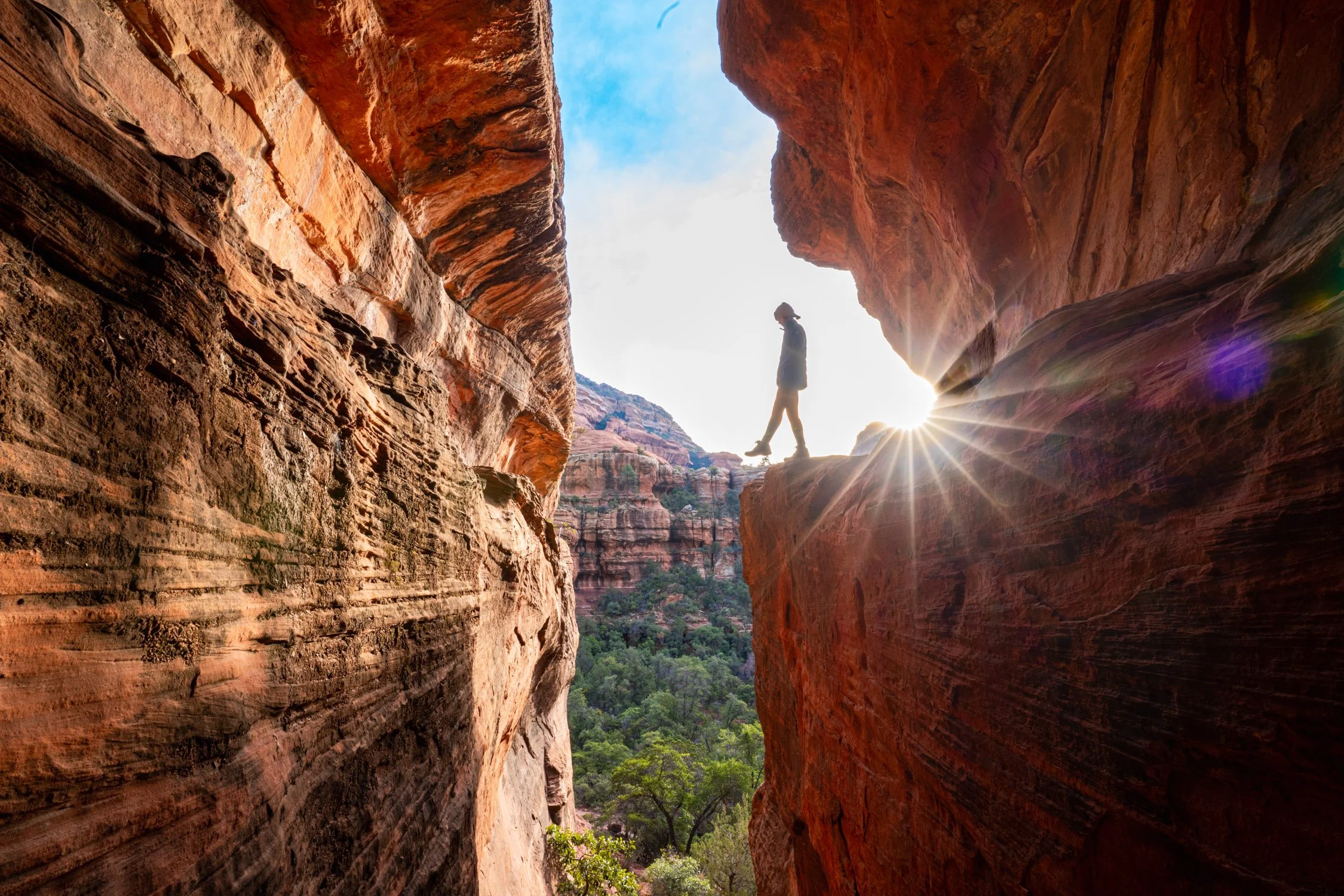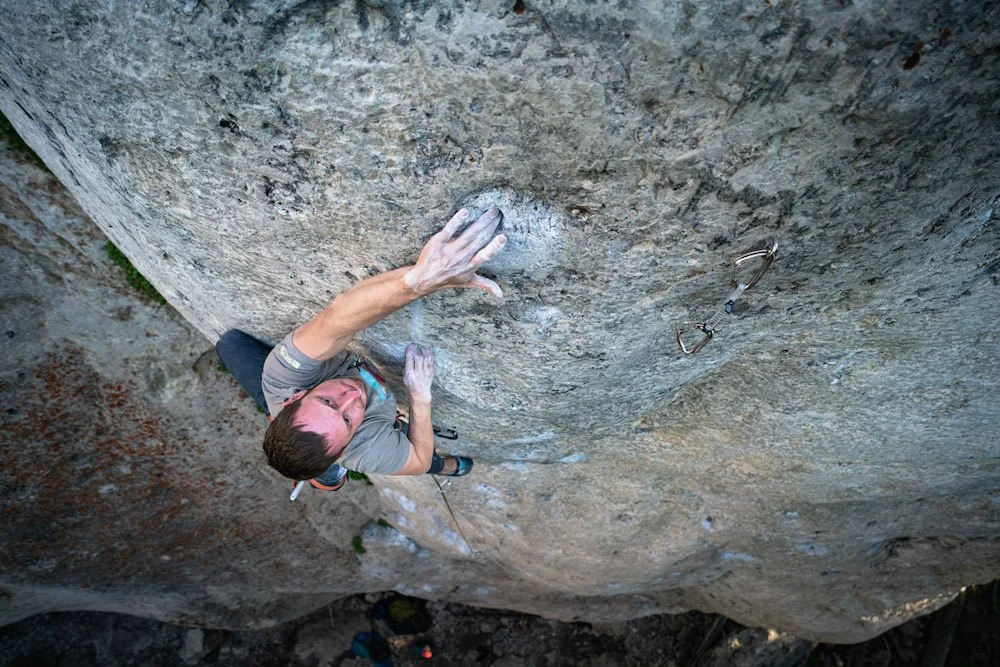Hiking is not just a physical activity; it's a transformative journey that offers a plethora of benefits for both body and mind. From improving cardiovascular health and muscle strength to reducing stress and fostering a deeper connection with nature, hiking is a holistic experience that can change your life. In this comprehensive guide, we will explore every aspect of hiking, from essential gear and trail selection to navigation basics and Leave No Trace principles, empowering you to embark on your hiking journey with confidence and knowledge.
Hiking the Subway Cave in Sedona, AZ. Photo by Dalton Johnson
Shedding the Couch Potato Skin: Essential Gear for Beginners
Embarking on a hiking adventure starts with the right gear. Each piece of equipment plays a crucial role in ensuring your safety, comfort, and enjoyment on the trail.
Footwear
One of the most critical pieces of gear for any hiker is proper footwear. Hiking boots or shoes provide essential ankle support and traction on uneven terrain, protecting you from injuries and enhancing your stability. Look for boots/shoes that are waterproof, breathable, and properly fitted to your foot shape.
Clothing
Choosing the right clothing is vital for staying comfortable and protected from the elements. Opt for breathable, moisture-wicking fabrics that help regulate your body temperature and keep you dry. Dress in layers to easily adjust to changing weather conditions, and don't forget sun protection with a wide-brimmed hat and UV-blocking sunglasses.
Hydration Pack/Water Bottle
Staying hydrated is key to a successful hike. Invest in a hydration pack or water bottle that suits your needs and the length of your hike. A hydration pack allows for hands-free drinking and usually has a larger capacity, ideal for longer treks. Remember to drink water regularly, even if you don't feel thirsty, to prevent dehydration.
Daypack
A well-equipped daypack is your hiking companion, carrying all the essentials you'll need on the trail. Pack snacks to fuel your adventure, sunscreen to protect your skin, a compact first-aid kit for emergencies, and a lightweight, packable rain jacket for unexpected weather changes. Ensure your daypack fits comfortably and distributes weight evenly to prevent strain on your back and shoulders.
Optional Gear
While not essential, some optional gear can enhance your hiking experience. Trekking poles provide added stability, reduce strain on your joints, and help distribute weight more evenly, especially on steep ascents or descents. Consider investing in a quality pair if you plan on tackling challenging terrain. Additionally, gaiters can protect your lower legs from debris, water, and mud, keeping your feet dry and comfortable.
Choosing Your Trail: Conquering Comfort Before Everest
Selecting the right trail is crucial for a successful hiking experience, especially for beginners. Knowing your limits, conducting thorough research, and starting small can make a significant difference in your enjoyment and safety on the trail.
Know Your Limits
Before choosing a trail, assess your fitness level, hiking experience, and comfort with outdoor activities. Consider factors such as distance, elevation gain, trail difficulty, and terrain type. Start with shorter, easier trails to build confidence and endurance gradually.
Research is Key
Utilize online resources, hiking guidebooks, and ranger stations to gather information about potential trails. Pay attention to trail conditions, weather forecasts, facilities (such as restrooms and water sources), trail maps, and any permits or regulations required. Understanding what to expect beforehand can help you prepare effectively and make informed decisions.
Start Small, Dream Big
Begin your hiking journey with beginner-friendly trails that match your abilities and preferences. Look for well-marked, well-maintained trails with moderate terrain and minimal technical challenges. As you gain experience and confidence, gradually progress to longer, more challenging hikes and explore diverse landscapes and ecosystems.
Basic Navigation: Never Get Lost in the Adventure
Navigation skills are essential for staying safe and on course during a hike. Whether using traditional tools like maps and compasses or modern technology like GPS devices and smartphone apps, mastering basic navigation techniques is a fundamental aspect of hiking.
Map and Compass
Learning how to read a topographic map and use a compass is a valuable skill for navigating unfamiliar terrain. Understand map symbols, contour lines, scale, and legend to interpret the landscape accurately. Use your compass in conjunction with the map to determine direction, orient the map, and navigate along planned routes.
Downloadable Maps/GPS Apps
In addition to traditional navigation tools, consider using downloadable maps and GPS apps on your smartphone as supplemental aids. Many apps offer detailed trail maps, real-time GPS tracking, offline mode, and route recording features. However, rely on electronic devices responsibly, as battery life, signal availability, and device reliability can vary in outdoor environments.
Staying on Trail
Follow trail markers, signs, and blazes to stay on the designated route and avoid getting lost. Pay attention to trail junctions, landmarks, and natural features that can help you confirm your location and progress. If you do stray off course, backtrack to the last known point and reassess your navigation plan.
Leave No Trace: The Trailblazer's Code of Ethics
Responsible hiking involves minimizing your impact on the environment and preserving natural spaces for future generations. Familiarize yourself with Leave No Trace principles and adopt practices that prioritize conservation, sustainability, and respect for wildlife and ecosystems.
Principles to Remember
Plan Ahead and Prepare: Research your hike, pack appropriately, and anticipate potential challenges.
Travel and Camp on Durable Surfaces: Stick to designated trails and campsites to minimize vegetation damage.
Dispose of Waste Properly: Pack out all trash, including food wrappers, and properly dispose of human waste using designated facilities or techniques.
Leave What You Find: Avoid disturbing natural objects, plants, and artifacts. Take photos and memories instead.
Respect Wildlife: Observe animals from a safe distance, avoid feeding them, and minimize noise and disturbances.
Proper Waste Disposal
Carry a lightweight bear canister or use bear-proof storage methods to secure food and scented items, preventing wildlife encounters and food theft. Pack out all trash, including biodegradable items like food scraps and hygiene products. Follow established guidelines for waste disposal in backcountry areas, such as burying human waste in catholes at least 6-8 inches deep and 200 feet away from water sources.
Respecting Wildlife
Maintain a respectful distance from wildlife and refrain from approaching or feeding animals. Keep pets leashed and under control to prevent conflicts with wildlife and protect both animals and other hikers. Learn about local wildlife species, their habitats, and behaviors to minimize disruptions and promote coexistence.
Taking in the grand Alaskan views while on a backpacking trip around Kenai Fjords National Park. Photo by Dalton Johnson
Embarking on a hiking journey is a rewarding experience that allows you to reconnect with nature, challenge yourself physically and mentally, and discover new perspectives. By equipping yourself with the right gear, choosing suitable trails, mastering navigation skills, and practicing Leave No Trace principles, you can enjoy safe, fulfilling hikes while preserving natural environments for future generations. Start your hiking adventure today, embrace the outdoors, and leave a positive impact on the trails you explore.








